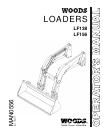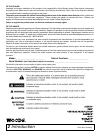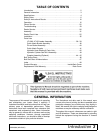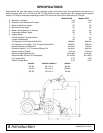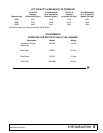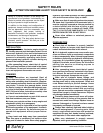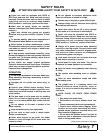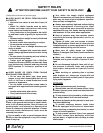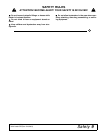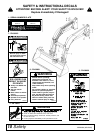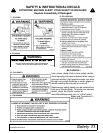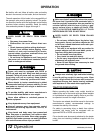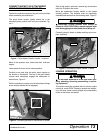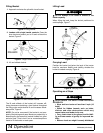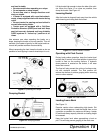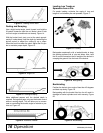
8 Safety
1020 Loader SR (Rev. 2/16/2007)
(Safety Rules continued from previous page)
AVOID INJURY OR DEATH FROM ROLLOVER
ACCIDENTS:
• Move and turn tractor at less than 6 mph (10
km/h).
• Watch for hidden hazards such as holes,
ditches, and other obstructions which may
cause tractor and loader to tip over.
• Carry loads close to the ground to aid visibil-
ity and lower center of gravity for improved sta-
bility.
• Balance loads so weight is evenly distributed
and load is stable.
• Be extra careful when operating on a slope.
• Do not operate on steep slopes.
• Do not stop, start or change directions sud-
denly on slopes.
• If loader is equipped with round bale attach-
ments, always approach bale with tractor facing
uphill.
• Be sure tractor tire spacing and rear ballast is
correct before using loader.
• Tractor must be equipped with a Roll-Over
Protective Structure (ROPS) and seat belt. Keep
seat belt securely fastened and keep foldable
ROPS systems in “locked up” position at all
times.
AVOID INJURY OR DEATH FROM FALLING
BALES AND OTHER OBJECTS:
• Do not carry hay bales, logs, fence posts,
stones, or any other loose objects that can roll,
shift, or fall from a raised bucket and crush
operator or bystanders.
• Do not handle round bales unless loader is
equipped with approved bale handling attach-
ment.
• Handle raised loads with caution.
• Carry loads low and drive slowly.
MAINTENANCE
Never work under a raised loader. Always lower
loader to the ground with bucket or loader attach-
ment in full roll-back position. Shut off tractor, set
parking brake, and remove key. Operate valve
levers to release any hydraulic pressure. If loader
obstructs tractor maintenance, loader must be
removed from tractor.
Do not modify or alter or permit anyone else to
modify or alter the equipment or any of its compo-
nents in any way.
Your dealer can supply original equipment
hydraulic accessories and repair parts. Substitute
parts may not meet original equipment specifica-
tions and may be dangerous.
Always wear relatively tight and belted clothing
to avoid entanglement in moving parts. Wear
sturdy, rough-soled work shoes and protective
equipment for eyes, hair, hands, hearing, and head;
and respirator or filter mask where appropriate.
Keep all persons away from operator control
area while performing adjustments, service, or
maintenance.
Tighten all bolts, nuts and screws to torque
chart specifications. Check that all cotter pins are
installed securely to ensure equipment is in a safe
condition before putting unit into service.
Make sure all safety decals are installed.
Replace if damaged. (See Safety Decals section for
location.)
Make sure shields and guards are properly
installed and in good condition. Replace if dam-
aged.
Do not disconnect hydraulic lines until all sys-
tem pressure is relieved. Lower unit to ground,
stop engine, and operate all hydraulic control
levers.
When servicing or replacing pins in cylinder
ends, buckets, etc., always use a brass drift and
hammer. Failure to do so could result in injury from
flying metal fragments.
STORAGE
Block equipment securely for storage.
Stored loader can fall and cause serious injury
or death. Securely store loader and attachments to
prevent falling.
To help prevent injury caused by a falling imple-
ment, always detach on a hard level surface.
Secure equipment parking stand(s) in park posi-
tion before detaching.
To provide necessary balance, loader frame
must be equipped with bucket or attachment
before attaching or detaching from tractor, or when
loader is in stored position.
To help prevent personal injury from exposed
fork tines, always store bale spear with tines
pointed down, or against bale, building or other
stable object.
SAFETY RULES
ATTENTION! BECOME ALERT! YOUR SAFETY IS INVOLVED!
(Rev. 9/21/2007)



